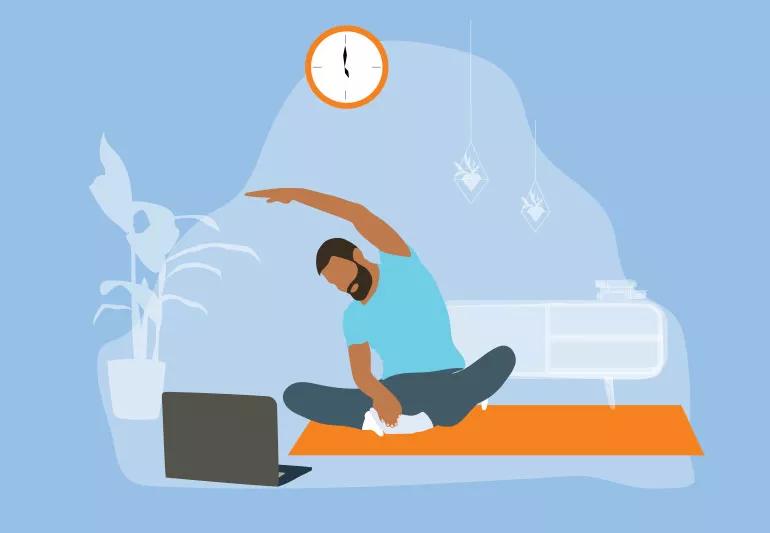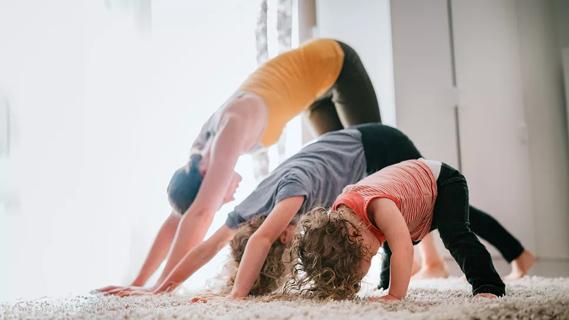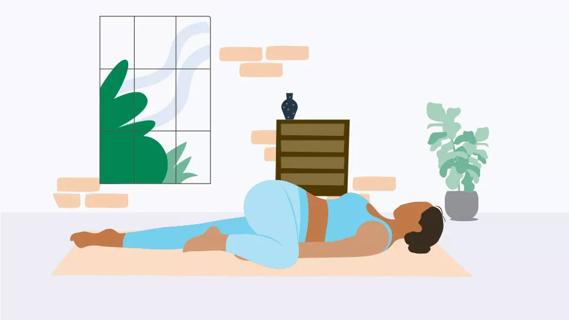Select a yoga class that focuses on your breath and promotes kindness toward yourself

The stress of everyday life can sap your energy and mood. If you’re feeling the weight of your job, family, finances or even the traffic, yoga can help.
Advertisement
Cleveland Clinic is a non-profit academic medical center. Advertising on our site helps support our mission. We do not endorse non-Cleveland Clinic products or services. Policy
According to yoga instructor and retired pediatrician Johanna Goldfarb, MD, yoga is the union of mind, body and breath. Through routine practice, you learn to calm your mind, relax your body and control your breath.
“These techniques are useful outside the yoga studio, too,” Dr. Goldfarb says. “If you’re in an aggravating line at the grocery store or a long meeting at work, you can use them to help you relax.”
Stress is a survival mechanism rooted deep in your DNA. Stressful situations trigger your nervous system to release adrenaline, a hormone that increases your heart rate and breathing.
“This fight-or-flight response helped our ancestors escape dangerous situations, like a charging lion,” explains Dr. Goldfarb. “But in the modern day, we are in a state of chronic stress of always being ready for the worst. Yoga is excellent at activating a relaxation response that counters chronic stress.”
Other health benefits of yoga include:
Yoga began in India thousands of years ago. Over time, many types have evolved. The oldest forms of yoga have Sanskrit names, such as Hatha, Vinyasa and Ashtanga. Some newer styles carry the name of their founders, like Iyengar and Bikram. In the U.S., classes often have more general titles, such as restorative, flow or power yoga.
Advertisement
The different forms of yoga have distinct characteristics. Some move quickly from one pose to another, while others hold poses for a long time. Some focus on flexibility and relaxation, while others are very dynamic and strenuous. But they all share the mind-body-breathe connection.
Understanding the various yoga styles and finding one that is right for you can be challenging. These seven common types of yoga are the starting point for exploring this ancient practice and its physical, emotional and spiritual dimensions.
Technically, Hatha is a catchall term for any physical yoga that includes postures and breathwork. In the West, Hatha yoga is its own style. When you see a class advertised as Hatha, you can expect a general style that combines a mix of standing and seated poses.
Hatha yoga focuses on strengthening, relaxation and flexibility. You move from one pose to another, holding each for several breaths. Your instructor provides detailed instructions throughout the class.
Hatha yoga is excellent for beginners. “A Hatha class is a good place to start because it teaches the foundations of yoga and an awareness of your breath and body,” says Dr. Goldfarb.
Restorative and Yin yoga are two types of slow, meditative, floor-based yoga. Both offer stillness and an opportunity to rest and recharge. But each has a unique goal.
Yin yoga involves long, deep, active stretching. It aims to improve flexibility of muscles and connective tissues. The main features of Yin yoga are:
Restorative yoga aims for complete mental and physical relaxation. In restorative yoga, you:
Both types of yoga can help relieve the pressures of daily life and are suitable for students of all levels. They’re also perfect for adding to your weekly routine if you practice other types of yoga or athletic activities.
“Restorative yoga is best if you want a restful, healing experience,” says Dr. Goldfarb. “Yin yoga requires more practice and patience to achieve a deep stretch but can be physically and mentally rewarding.”
Developed by B.K.S. Iyengar, Iyengar yoga is accessible to people of all abilities and in all stages of life. It’s a slow, strong practice that includes standing and seated poses held for longer periods.
The central hallmark of Iyengar yoga is the use of props, such as chairs, blocks and straps. Props help people achieve postures while maintaining proper alignment.
Advertisement
Iyengar yoga instructors are trained and certified to provide detailed instructions and assistance. “Iyengar yoga is good for all ages and skill levels, including people with injuries or physical limitations,” says Dr. Goldfarb.
Vinyasa yoga, also known as flow, is an active style of yoga. It’s a moving meditation that takes you through loops of postures. Vinyasa yoga features:
“Flow yoga is a good choice for experienced students who want a more dynamic class,” says Dr. Goldfarb. “If you are a beginner, look for a slow flow class that moves at a more relaxed pace and can help you learn the movements.”
These types of yoga are performed in a heated studio and are intense and challenging.
Bikram yoga, named after its founder Bikram Choudhury, is a 90-minute class in a room heated to 104 degrees Fahrenheit (40 degrees Celsius). It includes 26 fixed poses and two breathing exercises you perform in the same order each class.
Hot yoga is less structured and includes classes of varying sequences, intensities and heat.
In general, the benefit of heat is that it allows your body to open up and stretch beyond your usual flexibility. Because you sweat a lot, proper hydration is essential. Dr. Goldfarb cautions that hot yoga can be stressful on your body. It’s best for people in good health and with previous yoga experience.
Advertisement
Ashtanga yoga is a fluid form of yoga that contains six levels, each with a set order of poses. The levels range from beginning to advanced, but even the entry levels are challenging. The primary series (the easiest level) takes 90 minutes to complete and includes backbends and headstands. As with other yoga styles, your breath and focus are key as you move through the postures.
You might like Ashtanga yoga if you prefer a physically demanding class that uses a fixed sequence of poses each time. “Ashtanga is an intense form of yoga,” says Dr. Goldfarb. “You can modify the postures based on your ability. But you’ll want to learn more about it and find an instructor you trust before diving in.”
Power yoga is similar to Ashtanga yoga but doesn’t involve set postures. It’s a flowing, athletic class that gives you a full-body workout while still linking breath and movement. Some studios offer power yoga in a heated room to increase your sweat level. You’ll find some classes set to music.
Power yoga is ideal for people who want to burn calories and increase strength and endurance. Individual studios and instructors have their own vibe. Experiment to find one that matches your personality and fitness level, recommends Dr. Goldfarb.
Advertisement
Many people start yoga as a path toward improved health, reduced stress and self-discovery. Sustained yoga practice can fulfill all these goals. But how do you find a practice, studio and instructor that’s right for you?
Dr. Goldfarb recommends asking these questions:
The first step is to decide what you want out of a yoga class. Your goals may include:
Next, think about what type of class you might prefer. Would you like a relaxing, still class or an active and challenging one?
Before choosing, Dr. Goldfarb recommends talking to your healthcare provider to make sure yoga is safe for you. Then, start with a basic class. Look for a beginner Hatha, slow flow or restorative class in your area. If you have some experience and want a class that incorporates more physical movement and strengthening, try Ashtanga or power yoga.
All yoga studios should offer descriptions of their classes and allow you to observe the first class. Whether you’re a beginner or an advanced yoga student, you can find a class that meets your needs.
A yoga studio with friendly, experienced and helpful instructors will help motivate you to keep coming back. During your first visit, staff should:
“Finding an instructor who can help you reach your goals is essential,” says Dr. Goldfarb. Make sure the teacher is certified through the Yoga Alliance or another prominent organization. Regardless of the yoga class you choose, your instructor should:
Yoga classes should provide a welcoming, supportive environment free from judgment and competition. You should never experience pain or discomfort. Be sure to find a class that allows you to advance at a pace that’s comfortable for you.
As you experiment with different yoga classes, you’ll find that some classes align with your ideals more than others. “Finding a class that focuses on the breath, promotes self-kindness and feels safe is what matters most,” encourages Dr. Goldfarb.
Learn more about our editorial process.
Advertisement

This gentle yoga stretch supports your spine, strengthens your core and calms your mind

Focus on inhaling and exhaling through 12 steps of a complete sequence

Stand tall and feel grounded with this foundational yoga pose

This transitional and restorative yoga pose provides a full-body stretch

Somatic yoga focuses on the sensation and experience of movement — not striking perfect poses

Balasana, or child’s pose, is a restorative full-body yoga technique

Kids’ yoga can help kiddos become more aware of their physical, mental and emotional selves

This mindful practice is designed to give you mental and physical relaxation

If your nose is constantly running, it could be allergies, chronic sinusitis, nasal polyps or other concerns

If you find yourself obsessing over rejection or a one-sided relationship, you’re likely stuck in limerence

Alcohol is a depressant and can interfere with your sleep, mood and more